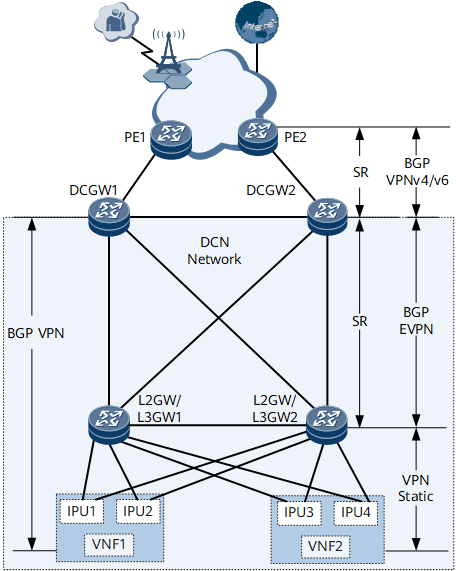Configuring the NFVI Distributed Gateway Function (SR Tunnels)
In the network function virtualization infrastructure (NFVI) telco cloud solution, the NFVI distributed gateway function allows mobile phone service traffic to be transmitted to virtual unified gateways (vUGWs) and virtual multiservice engines (vMSEs) through a SR tunnel over a data center network (DCN) in load balancing mode.
Usage Scenario
The NFVI telco cloud solution uses the data center interconnect (DCI)+DCN networking. A large amount of mobile phone traffic is sent to virtual unified gateways (vUGWs) and virtual multiservice engines (vMSEs) on the DCN. After being processed by the vUGWs and vMSEs, the mobile phone traffic is forwarded over the DCN to destination devices on the Internet. The destination devices send traffic to mobile phones in similar ways. To achieve these functions and ensure traffic load balancing on the DCN, you need to deploy the NFVI distributed gateway function.
Figure 1 shows the networking of an NFVI distributed gateway (SR tunnels). DC-GWs, which are the border gateways of the DCN, exchange Internet routes with external devices over PEs. L2GW/L3GW1 and L2GW/L3GW2 are connected to virtualized network function (VNF) devices. VNF1 and VNF2 that function as virtualized NEs are deployed to implement the vUGW functions and vMSE functions, respectively. VNF1 and VNF2 are connected to L2GW/L3GW1 and L2GW/L3GW2 through interface process units (IPUs).
Establish BGP VPN peer relationships between VNFs and DC-GWs so that the VNFs can advertise mobile phone routes (UE IP) to DC-GWs.
On L2GW/L3GW1 and L2GW/L3GW2, configure static VPN routes with the IP addresses of VNFs as the destination addresses and the IP addresses of IPUs as next-hop addresses.
Establish BGP EVPN peer relationships between any DC-GW and L2GW/L3GW. L2GW/L3GWs can then flood the static routes destined for VNFs to other devices based on the BGP EVPN peer relationships. DC-GWs can then advertise local loopback routes and default routes to L2GW/L3GWs.
Establish BGP VPNv4/v6 peer relationships between DC-GWs and PEs. DC-GWs can then advertise mobile phone routes to PEs and receive the Internet routes sent by external devices based on the BGP VPNv4/v6 peer relationships.
Deploy SR tunnels between PEs and DC-GWs and between DC-GWs and L2GW/L3GWs to carry service traffic.
The traffic transmitted between mobile phones and the Internet over VNFs is north-south traffic. The traffic transmitted between VNF1 and VNF2 is east-west traffic. To achieve load balancing of east-west traffic and north-south traffic, deploy the load balancing function on DC-GWs and L2GW/L3GWs.

The NFVI distributed gateway function supports both IPv4 and IPv6 services. If a step does not differentiate IPv4 and IPv6 services, this step applies to both IPv4 and IPv6 services.
Pre-configuration Tasks
Before configuring the NFVI distributed gateway function, complete the following tasks:
Allow the routes between PEs and DC-GWs and between DC-GWs and L2GW/L3GWs to be reachable.
Deploy SR tunnels between PEs and DC-GWs and between DC-GWs and L2GW/L3GWs.
Configure the BD EVPN function on DC-GWs and L2GW/L3GWs. The configuration includes creating EVPN instances and L3VPN instances, establishing BGP EVPN peer relationships, and configuring VBDIF interfaces.
Deploy the EBGP VPNv4 or EBGP VPNv6 function between PEs and DC-GWs.
Configure the static routes destined for VNF1 and VNF2 on L2GW/L3GWs by referring to Static VPN IPv4 Routes or Static VPN IPv6 Routes.
- Configuring Route Recursion over SR Tunnels
- If SR tunnels are used to carry service traffic, the function to recurse routes over SR tunnels must be configured.
- Configuring Route Advertisement on DC-GWs
- Route advertisement can be configured on DC-GWs to allow the DC-GWs to construct their own forwarding entries based on the received EVPN or BGP routes.
- Configuring Route Advertisement on L2GW/L3GWs
- Route advertisement can be configured on L2GW/L3GWs to allow the L2GW/L3GWs to construct their own forwarding entries based on the received EVPN or BGP routes.
- (Optional) Configuring the Load Balancing Function
- The load balancing function needs to be deployed to achieve balanced loads of network traffic.
- Verifying the Configurations of the NFVI Distributed Gateway Function
- After configuring the NFVI distributed gateway function, verify the configurations. On DC-GWs, you can view the VPN peer relationships between DC-GWs and VNFs and the information about the mobile phone routes received from VNFs.
